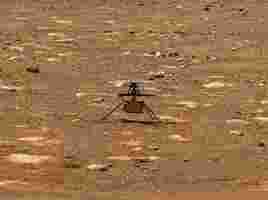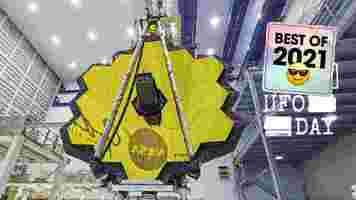How an old smartphone processor will power the first-ever flight on Mars
If you’ve got a new Android phone, its processor is probably more advanced than the one that will control the first-ever flight on Mars.

NASA‘s Ingenuity helicopter, which is slated to make its maiden voyage on the red planet on April 14, is powered by Snapdragon’s 801 processor — the same chip used by a slew of phones released in 2014 and 2015.
The system runs an integrated board called the Qualcomm Flight Platform, which will operate the autonomous flight.


While staff at NASA’s Jet Propulsion Laboratory (JPL) will plan the chopper’s route, the flight will be autonomous due to communication delays. Radio signals will take over 15 minutes to travel the 173 million miles between Earth and Mars.
“There’s no fly-by wire, there’s nobody remote controlling, so most of the intelligence has to be done on the platform,” Dev Singh, Qualcomm’s GM of robotics, drones, and intelligent machines, tells TNW.
Qualcomm’s platform will process information captured by two cameras and multiple sensors attached to the 1.8-kilogram helicopter. This data will feed back into the algorithms that guide Ingenuity’s movements.
If obstacles or conditions on Mars set the drone off course, the system will adjust the controls.
“Our entire flight model is based on the sensors onboard as well as the computer vision — what I like to call flight by sight,” says Chris Pruetting, senior director of business development for Qualcomm Government Technologies.
Qualcomm Flight is also used in the communication system of the Perseverance rover, which gave Ingenuity a ride to the red planet.
On the buggy, the platform will process photos taken by the helicopter before they’re sent back to Earth.
“ Those of us here are really excited about the pictures that Ingenuity takes,” says Pruetting. “The folks at JPL are really excited about all the data that comes back as part of that because they’re going to learn a lot about space flight on Mars.”
NASA will use the insights to develop more advanced helicopters, which could access areas of Mars that ground vehicles can’t reach.
Greetings Humanoids! Did you know we have a newsletter all about AI? You can subscribe to it right here .
Nvidia confirms it’s buying Arm for $40B to expand its AI efforts
Graphics hardware and AI giant Nvidia has confirmed its long-rumored acquisition of UK-based chip design firm Arm from SoftBank in a $40 billion transaction slated to be completed over the next 18 months.

The deal will see Nvidia further develop its AI computing platform to reach more devices and applications, while also radically reshaping the global semiconductor industry. Jenson Huang, the company’s CEO, noted:
Arm, which designs processors for a wide range of consumer products including phones and laptops, will retain its headquarters in Cambridge, but also add on an AI-focused R&D center there. The goal is to not only develop chips for the aforementioned applications, but also to allow Nvidia to “build a state-of-the-art AI supercomputer, powered by Arm CPUs.”
The deal will see Nvidia pay $12 billion in cash and $21.5 billion in sales. SoftBank and its $100 billion Vision Fund will get a stake of between 6.7% and 8.1% in Nvidia.
So you’re interested in AI? Then join our online event, TNW2020 , where you’ll hear how artificial intelligence is transforming industries and businesses.
Why aliens should be terrified of NASA’s new space telescope
NASA’s James Webb Space Telescope (JWST) is set to launch real soon — on December 25 at 07:20am EST (12:20 GMT/UTC) to be precise — and the scientific community is buzzing with anticipation. Some scientists are excited at the prospect of ‘traveling through time’ to discover the origin story of our universe, while others hope it’ll help us connect the dots between classical and quantum physics.

But at least one researcher believes the JWST could be a harbinger of ill tidings. In an interview over the weekend, world-renowned physicist Michio Kaku, one of the scientists responsible for string theory, told the Guardian that he didn’t think humans should contact any aliens we find. Here’s the relevant snippet:
It’s interesting that Kaku would bring up Montezuma and Cortes in the context of first contact. As legend has it , Montezuma II accidentally ceded the entire Aztec empire to Cortes, a Spanish Conquistador, over a language misunderstanding.
According to historians, Montezuma II told Cortes he’d been keeping the Aztec throne warm for him, but he meant it in a bragging sarcastic way. Cortes apparently didn’t get the tone, and the rest is history.
It seems like Kaku’s warning is that, were we to find and contact aliens, Earthlings could be the Aztecs and aliens would be the Spaniards. Maybe we send a message such as “we come in peace” when we discover them and the aliens interpret it to mean “come rule us.” It could happen.
We could engage in endless conjecture when it comes to discussing what might happen if/when we discover alien life. Instead, let’s just take a moment to state some key facts about the JWST so we can see how they tie into what we might find, ET-wise, when it gets where it’s going:
NASA’s sending the telescope to the second Lagrange point (L2). This is a special place where the telescope can stay in line with the Earth while it orbits around the sun 1.5 million kilometers away from home. The Hubble, on the other hand, just hung out right above our planet a mere 547 kilometers away.
Thanks to this incredible vantage point, the JWST will allow us to see and study the cosmos in new and exciting ways. The JWST will allow researchers to study the origins of the universe and, with any luck, find planets in our galaxy capable of supporting life. And that means we could, hypothetically, discover aliens with it as early as next year.
What would that mean? We have no way of knowing what kind of aliens we might discover. Perhaps they’ll be amoeba-like. Or maybe we’ll find a fledgling planet where flora and fauna flourish, but intelligence hasn’t evolved yet. And, yes, it could even mean we find intelligent life. The only thing we can know for sure is that any life we do manage to find should be very, very afraid.
Nearly every civilization that’s inhabited Earth either warred with other civilizations or was dominated by one or more that did. Even today, Earth is inhabited by 8 billion people who exist under a planet-wide policy of mutually assured destruction.
NASA is a government entity of the US, a country that’s currently fighting the longest war in its history. Objectively speaking, almost everything about the state of our world indicates violence is inevitable where humans are involved. If we meet an intelligent species, we’re likely to go to war.
And the prognosis is even worse for any unintelligent life forms we come across. More than 41,000 species on Earth are currently endangered . In order to protect any alien critters we meet from our ceaseless destruction, we’ll need to treat their worlds with far greater reverence and respect than we do our own.
Still, there’s no guarantee there’s any life out there. And even if there is, it could still take decades, centuries, or millennia for us to venture out far enough or develop the right technology to find it. But if there is, and they aren’t powerful enough to stop us from doing what we always do, here’s hoping we don’t find them until we learn how to be better neighbors to everyone, ourselves included.